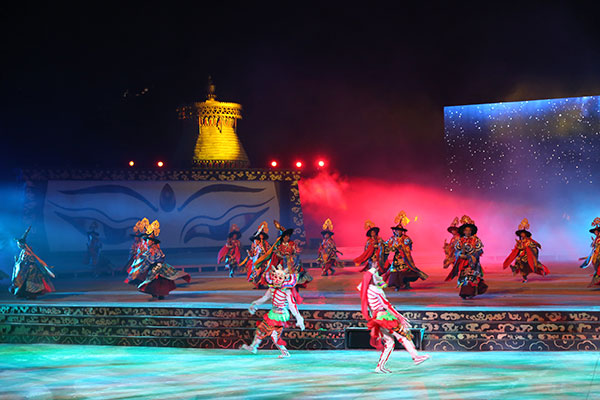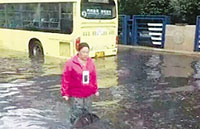Tibetan opera offers amateur actors extra income
By Palden Nyima (chinadaily.com.cn) Updated: 2016-06-20 13:40
 |
|
The opera highlights local culture with its costumes, music and dances. [Photos by Palden Nyima/China Daily] |
Performed at 4,020 meters above sea level in the Tibet autonomous region's Gyaltse county, "Gyaltse Traces" is believed to be the world's highest live action opera.
It was first staged in August 2014, using aid money from the Shanghai municipal government, and commemorates resistance to the British invasion of Tibet in 1904.
This year's run began on Wednesday evening in Gyaltse's Damag Square, which is surrounded by the ancient Gyaltse Castle, Palgong Stupa, and Norbu Hill.
The opera reflects the culture of Gyaltse, an important grain producing region to the south of Xigaze whose name means "summit of victory" in the Tibetan language, while simultaneously telling the story of its agriculture civilization and Tibet's peaceful liberation.
More than 300 local farmers and nomads have been recruited to work as actors and actresses in the opera, supplementing their daily income by appearing on stage in the evenings.
One such player is Basang Norgyal, who said the opera aims to "remind the younger generations to remember their true history".
"It's my honor to have been playing in the opera for three years, it makes life meaningful and joyful, and I believe my continuous participation will make me have a longer life," said the 63-year-old, who is paid 100 yuan ($15) for each show he appears in.
Phurbu Butri, a dancer, said she treasured the opportunity to be in the production and provide her family with another source of income.
"I consider my participation in the play as a chance to do sports, and it makes me feel happy as it is also an amusing activity," said the 29-year-old, adding that she hoped more tourists would come and watch the opera in future.
"Not only can they experience unique local Tibetan dances, songs, and Tibetan opera, they can also learn more about Tibetan culture and history," she said.
Pedron, another actress in the opera, said she received a salary of 3,000 yuan per month for her work with the production.
"My family condition was poor in the past, but since becoming an actress for the opera, I am no longer a burden on the government," said the 57-year-old.
"It is not only a job, my communication skills have also improved a lot."
Han Sheng, a professor at Shanghai Theatre Academy and the opera's art director, said Tibet's cultural resources would help attract more visitors to the region, and Gyaltse in particular.
"With its fascinating landscape, harmonious ecology, and rich cultural resources, Gyaltse is a place with interesting stories," said Han.
"Our obligation is to share these stories, and make them known worldwide, to attract more people here, and to turn these resources into jobs."
Officials at Gyaltse's tourism bureau said the live action opera not only highlights the county's culture and history, it also provides an opportunity for locals to benefit economically.
"The opera demonstrates the county's unique intangible cultural heritage, such as its ancient dances, six-stringed guitar songs, and the special festivals of Vonkhor and Damag," said Kalsang Dawa, deputy head of the county's tourism bureau.
"More than 300 local farmers and herdsmen have participated in the opera as players, and they can earn an average salary of 3,000 yuan per month. It is a big contribution for the local residents to boost their income."
The opera is the first of its kind in Tibet, with no equal in any of the region's 74 counties.
According to the tourism bureau, Gyaltse received 84,500 tourists last year and tourism revenue hit 29 million yuan.
- Students paying $15,000 to consultants to select college
- US urged not to meddle with internal Tibet affairs
- China puts squeeze on imported TV shows and remakes
- Apple's appeal in iPhone case accepted by IP court
- China on yellow alert for rainstorms
- Disney visitors soak up a new experience
- China vows better care for children in difficulty
- Global reach targeted in Beidou drive
- Switzerland to open 9 new visa centers in China
- Planned Obama, Dalai Lama meeting protested










